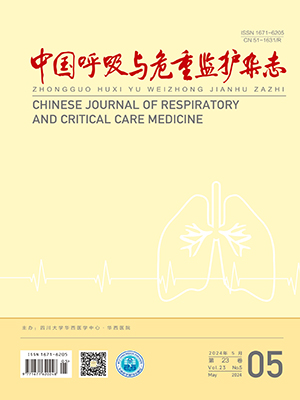| 1. |
罗汶鑫, 胡丹婧, 李为民. 年轻非小细胞肺癌的临床病理特征及预后研究. 中国呼吸与危重监护杂志, 2020, 19(5): 483-488.
|
| 2. |
Chen P, Liu Y, Wen Y, et al. Non‐small cell lung cancer in China. Cancer Communications, 2022, 42(10): 937-970.
|
| 3. |
Wei X, Li X, Hu S, et al. Regulation of Ferroptosis in Lung Adenocarcinoma. International Journal of Molecular Sciences, 2023, 24(19): 14614.
|
| 4. |
Lu D, Yang J, Liu X, et al. Clinicopathological features, survival outcomes, and appropriate surgical approaches for stage I acinar and papillary predominant lung adenocarcinoma. Cancer Medicine, 2020, 9(10): 3455-3462.
|
| 5. |
Herbst RS, Morgensztern D, Boshoff C. The biology and management of non-small cell lung cancer. NATURE, 2018, 553(7689): 446-454.
|
| 6. |
Liu W, Tang X, Qi X, et al. The Ubiquitin Conjugating Enzyme: An Important Ubiquitin Transfer Platform in Ubiquitin-Proteasome System. Int J Mol Sci, 2020, 21(8): 2894.
|
| 7. |
Bui QT, Hong JH, Kwak M, et al. Ubiquitin-Conjugating Enzymes in Cancer. Cells, 2021, 10(6): 1383.
|
| 8. |
Hosseini SM, Okoye I, Chaleshtari MG, et al. E2 ubiquitin-conjugating enzymes in cancer: Implications for immunotherapeutic interventions. Clin Chim Acta, 2019, 498: 126-134.
|
| 9. |
Grzmil P, Altmann ME, Adham IM, et al. Embryo implantation failure and other reproductive defects in Ube2q1-deficient female mice. Reproduction, 2013, 145(1): 45-56.
|
| 10. |
Seghatoleslam A, Nikseresht M, Shafiee SM, et al. Expression of the novel human gene, UBE2Q1, in breast tumors. Mol Biol Rep, 2012, 39(5): 5135-5141.
|
| 11. |
Shafiee SM, Seghatoleslam A, Nikseresht M, et al. UBE2Q1 expression in human colorectal tumors and cell lines. Mol Biol Rep, 2013, 40(12): 7045-7051.
|
| 12. |
Chang R, Wei L, Lu Y, et al. Upregulated expression of ubiquitin-conjugating enzyme E2Q1 (UBE2Q1) is associated with enhanced cell proliferation and poor prognosis in human hapatocellular carcinoma. Journal of Molecular Histology, 2014, 46(1): 45-56.
|
| 13. |
Zhang B, Deng C, Wang L, et al. Upregulation of UBE2Q1 via gene copy number gain in hepatocellular carcinoma promotes cancer progression through β-catenin-EGFR-PI3K-Akt-mTOR signaling pathway. Molecular Carcinogenesis, 2018, 57(2): 201-215.
|
| 14. |
Zhan P, Xi G, Zhang B, et al. NCAPG2 promotes tumour proliferation by regulating G2/M phase and associates with poor prognosis in lung adenocarcinoma. Journal of Cellular and Molecular Medicine, 2016, 21(4): 665-676.
|
| 15. |
Xia C, Dong X, Li H, et al. Cancer statistics in China and United States, 2022: profiles, trends, and determinants. Chinese Medical Journal, 2022, 135(5): 584-590.
|
| 16. |
Dastsooz H, Cereda M, Donna D, et al. A Comprehensive Bioinformatics Analysis of UBE2C in Cancers. International Journal of Molecular Sciences, 2019, 20(9): 2228.
|
| 17. |
Hou L, Li Y, Wang Y, et al. UBE2D1 RNA Expression Was an Independent Unfavorable Prognostic Indicator in Lung Adenocarcinoma, but Not in Lung Squamous Cell Carcinoma. Disease Markers, 2018, 2018: 1-8.
|
| 18. |
Li H, Niu H, Peng Y, et al. Ubc9 promotes invasion and metastasis of lung cancer cells. Oncology Reports, 2013, 29(4): 1588-1594.
|
| 19. |
Ma X, Qi W, Yang F, et al. UBE2L3 promotes lung adenocarcinoma invasion and metastasis through the GSK-3β/Snail signaling pathway. Am J Transl Res, 2022, 14(7): 4549-4561.
|
| 20. |
Qin Y, Du J, Fan C. Ube2S regulates Wnt/β-catenin signaling and promotes the progression of non-small cell lung cancer. International Journal of Medical Sciences, 2020, 17(2): 274-279.
|
| 21. |
Zhou W, Xu J, Li H, et al. Neddylation E2 UBE2F Promotes the Survival of Lung Cancer Cells by Activating CRL5 to Degrade NOXA via the K11 Linkage. Clinical Cancer Research, 2017, 23(4): 1104-1116.
|
| 22. |
Zhu J, Ao H, Liu M, et al. UBE2T promotes autophagy via the p53/AMPK/mTOR signaling pathway in lung adenocarcinoma. Journal of Translational Medicine, 2021, 19(1): 374.
|
| 23. |
Topno R, Singh I, Kumar M, et al. Integrated bioinformatic analysis identifies UBE2Q1 as a potential prognostic marker for high grade serous ovarian cancer. BMC Cancer, 2021, 21(1): 220.
|
| 24. |
Fahmidehkar MA, Shafiee SM, Eftekhar E, et al. Induction of cell proliferation, clonogenicity and cell accumulation in S phase as a consequence of human UBE2Q1 overexpression. Oncol Lett, 2016, 12(3): 2169-2174.
|
| 25. |
Shafiee SM, Rasti M, Seghatoleslam A, et al. UBE2Q1 in a Human Breast Carcinoma Cell Line: Overexpression and Interaction with p53. Asian Pacific Journal of Cancer Prevention, 2015, 16(9): 3723-3727.
|




